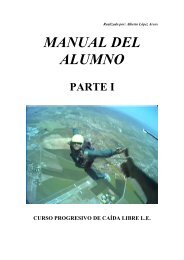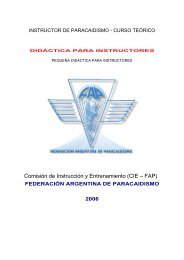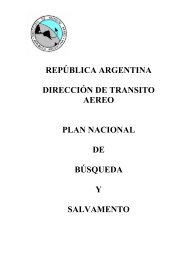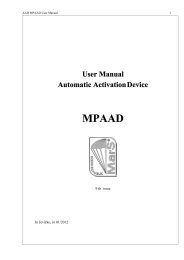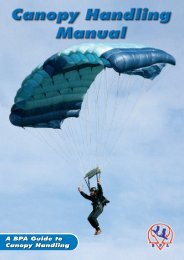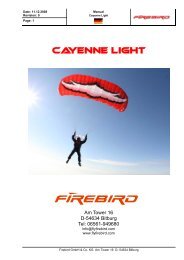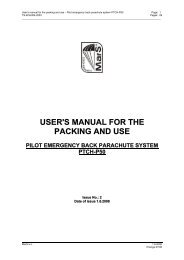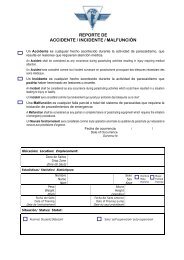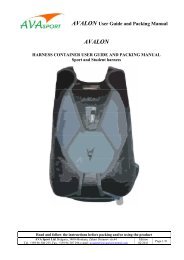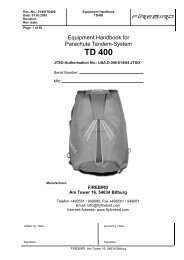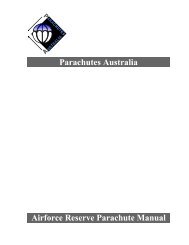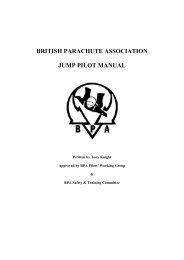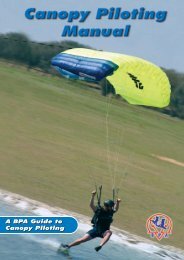Create successful ePaper yourself
Turn your PDF publications into a flip-book with our unique Google optimized e-Paper software.
EXPLORE THE FLIGHT<br />
Getting it on<br />
With the suit on the ground, slide yourself feet first into your legs straps and through the legs of the suit. Bring the<br />
suit and rig over your shoulders. (You will soon develop a quick and easy technique.)<br />
➤ Tighten your legs straps as if you were in freefall.<br />
➤ Don the booties and close the leg zippers. Secure the zippers with the snaps.<br />
➤ Close the zippers on your chest.<br />
Fasten your chest strap tightly.<br />
➤ Close the arm zippers, locking the zipper catch at the very end of the zipper. Put the thumb cords in<br />
place (around your thumb and OVER your altimeter).<br />
➤<br />
B IRD AN<br />
➤<br />
➤<br />
➤<br />
➤<br />
➤<br />
➤<br />
➤<br />
➤<br />
➤<br />
BEFORE BOARDING THE AIRCRAFT:<br />
Make sure that your wings are correctly assembled and that the cutaway cables are correctly routed.<br />
Ensure that emergency handles are in position and are not hindered or covered.<br />
Fasten your chest strap tightly.<br />
Ensure that your leg straps are fastened and snug inside the suit.<br />
M<br />
Check that the arm zippers and thumb cords are in good condition.<br />
Have someone give you a pin check.<br />
Check that the BOC throw-out pilot chute and handle are in the correct position.<br />
Do some practice pulls before you enter the aircraft to ensure that you can reach your pilot chute,<br />
and to ensure that it is in correct position. To do so, touch your pilot chute handle with your right<br />
hand while bringing your left arm in symmetrically and closing your leg wing.<br />
After your practice pulls, rehearse getting out of your wings. One at a time, open both of your arm<br />
zippers with a controlled, rapid movement. Unzip to the top of your shoulders for full range of<br />
motion. Simulate reaching the risers. Repeat this until you feel comfortable with the procedure.<br />
Prepar<br />
epare e for flight<br />
WEATHER CONDITIONS<br />
Because you can fly long distances with the suit, make sure that the weather conditions allow you to have visual<br />
contact with the ground at all times during your flight. Remember that the same physical laws apply to you as<br />
to any non-powered flyer. You travel longer and faster in relation to the ground when you fly with the wind and the<br />
reverse happens when flying against the wind.<br />
BRIEFING YOUR FELLOW JUMPERS, PILOTS, ETC.<br />
Before entering the aircraft you need to brief your fellow jumpers and the pilot about your wing suit flight.<br />
Because your freefall time can be twice as long as conventional jumpers, it is safest to exit last (even after<br />
tandems). Make sure the jump pilot is informed about your wing suit flight!<br />
FLIGHT PATTERN<br />
Upon exit, fly 90° off the line of flight (perpendicular to it). How long you fly perpendicular to the line of flight<br />
depends on your spot. Keep your eyes on the DZ; when the time is right, turn 90° towards the dz and fly parallel<br />
to the line of flight. Your horizontal speed can exceed 100 mph, so know where you are and know where others<br />
are.<br />
! !<br />
Never fly across or near the line of flight.<br />
Always have a flight plan before you enter the aircraft.<br />
page 6<br />
BirdMan Inc. • 1665 N. Lexington Avenue, Suite 103 • DeLand • 32724 • Florida • USA<br />
Tel:+1 386 785 0800 • Fax:+1 386 785 0080<br />
Email: info@bird-man.com • Web: www.bird-man.com



